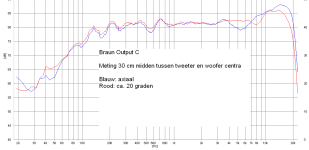I did, and I am technically within reason, you can use an EQ on a node, its practically ineffective but it won't stop you from applying a filter there...
You are saying words but it isn't in the proper or technically correct way... Of course you can equalize nodes. Just use an equalizer. You might not like the results is all.... Placing the speaker in a place where the resulting FR at the listening position isn't suffering from Nodes isn't the same as removing the effects of the room. Sorry.
Did you read the links? Do you understand the Physics of standing waves? I suggest you read into the links I provided you. They are based on classical Physics, easy to understand if you had at least the entry level year of Physics and gone up to Multivariate Calculus.
Not hard.
BTW, I'm not gonna get into a peeing context. Just read and learn, OK?
EDIT: .... forget it. Back to Two Way Speakers...
Last edited:
standing nodes
Its actually a Node or Antinode. Standing Node is the incorrect term. OK?
I was probably still forming my post, as I've shown for years now, my post isn't finished until the edit button disappears 😂
Did someone tell you these are BRAUN woofers?So, can someone help date or ID this vintage 8" Braun, back sticker "BR(tall A)UN 2621 604"? When I bought them I didn't think they sounded special, but they were part of a lot, with three British 8" vintage pairs. Quite nice as desktop LX midwoof over a classy short trash can, with Brit (to die for) on top as fullrange.
The chassis looks similar to some (full range) woofers with magnets from DEW Magnetfabrik Dortmund, but this factory had many clients, among which:
Heco Berlin, Peerless, RED Acoustic London, Braun, SEL, Philips, Blaupunkt, Wigo, Siemens, Telefunken, Studer, Canton, Saba, Acron.
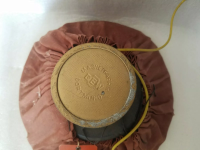
Last edited:
Much thanks for the reply. The seller didn't know much but each driver had a sticker with the stylized trademark (tall A) BRAUN and the same part-number, that was all. DEW happened to be my preferred German magnet brand based on listening to lots of clips and some actual drivers, but AFAIK they all had embossed brand markings (like your photo showed). So a mystery to me when/where this pair fit in Braun history. The three pairs of Brits were probably mid-to-late-1950s I think.Did someone tell you these are BRAUN woofers?
Last edited:
Your Braun/DEW woofer are from a time before Braun turned to the closed boxes with soft suspension, low Fs, that worked on a relative small volume of air.
Yours are from large open or aperiotic damped, low excursion speaker constructions. People that ignore objective performance may rate these high and today use them in "audiophile" constructions, like open baffles. Put them into one drawer with the SABA "green cones".
I would not waste time, energy and money on these. Maybe measure the TSP to get an idea what you got there.
PS they where made before 1976.
Yours are from large open or aperiotic damped, low excursion speaker constructions. People that ignore objective performance may rate these high and today use them in "audiophile" constructions, like open baffles. Put them into one drawer with the SABA "green cones".
I would not waste time, energy and money on these. Maybe measure the TSP to get an idea what you got there.
PS they where made before 1976.
It's not mine, but taken from local forum.
Not bad for a micro speaker that was already 40 years old at the time of measurement.
I'm not into vintage myself, even though I use some vintage drivers.
There's a lot to learn from the past.
Not bad for a micro speaker that was already 40 years old at the time of measurement.
I'm not into vintage myself, even though I use some vintage drivers.
There's a lot to learn from the past.
Last edited:
There are even more things in the past that went wrong for some reason. I think of many speaker and driver constructions...I'm not into vintage myself, even though I use some vintage drivers.
There's a lot to learn from the past.
Allow me to take this one (major) step further.People that ignore objective performance may rate these high and today use them in "audiophile" constructions, like open baffles. Put them into one drawer with the SABA "green cones".
I would not waste time, energy and money on these. Maybe measure the TSP to get an idea what you got there.
PS they where made before 1976.
In order to get closer to 'truth' it's best to first explore the 'extreme'.
This is how B. Putzeys and Hypex eventually arrived at the NCORE(x) technology.
"Feedback is at once a basic subject in engineering and a remarkably polarizing one in audiowith some saying it is evil and others saying that there is nothing wrong with it as long as you don’t overdo it. Bruno Putzeys finds himself in a camp all by himself, but not exactly in the middle…
-What are you writing?
-(carefully now…) An explanatory article about, uh, error control.
-Yay! “Ten feedback myths debunked!” By Mr Feedback in person! Or “to feedback or not to feedback?” That must be a ripping yarn! Nobody will see the punch-line coming.
-You said it. Now see this cudgel? It says “creativity prefers solitude”. Politely. Seriously.
I hate articles entitled “ten … myths debunked”. I would have to start by listing a roundnumber of clumsily worded claims by the non-feedback camp who probably never said any such thing, and juxtapose some simplified school-book explanations to put them right. And after shooting, flaying and roasting alive my straw men and generally hammering home that feedback doesn’t work like that, I should then fail to explain why not. This would leave an excellent status quo where everyone has had their say and truths remain somewhere in the middle.
I want to do better than that. It’s no proof of intelligence to open a debate pointing out the supposed “extremes” of the opinion spectrum and then taking some imagined middle ground. When person A says that 2+2=5 and person B says that 2+2=6, the most reasonable position to take is not five and a half. 2+2=5.5 can hardly be called moderate. In fact it is a very, very extreme claim. The author’s reputation for strong opinions notwithstanding, you will find no such extreme claims in this article" (widely known, but attached for convenience).
My question is 'what's next?'
Consider the concept of 'qualia' in this regard.
Attachments
There are even more things in the past that went wrong for some reason. I think of many speaker and driver constructions...
Wrong, or compromised?
In the 'early days' a lot of fundamental knowledge was gathered (also in Germany).
Some of that knowledge seems to have evaporated in favor of other aspects (often related to marketing).
If you are still talking about some old BRAUN 30cm drivers, these where designed with only one goal: Maximum SPL from very low power input.
Usually those large drivers got use in cinemas or other PA applications.
If you think of them as something special, my only advice is to measure them. Maybe that will show you what they really are: Gem or garbage.
Usually those large drivers got use in cinemas or other PA applications.
If you think of them as something special, my only advice is to measure them. Maybe that will show you what they really are: Gem or garbage.
It's called Verdande:
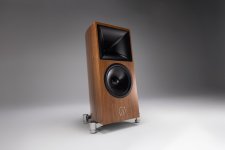

Cross-over is 1st order and this is the woofer:
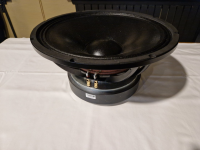
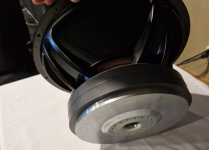


Specifications
- Sensitivity: 94db
- Frequency range: 26hz-20khz
- Impedance: 8ohm
- Horn: Quad Vertex Sound Field - Constant Directivity
- Woofer: 15" ultra-linear long stroke extended range woofer
- Feet: Polished stainless Steel with Tungsten resonance damping
- Dimensions: 1150x500x593mm (HxWxD)
- Weight: 100kg
- Price: $39,500/pair
Cross-over is 1st order and this is the woofer:


Last edited:
"Cross-over is 1st order"
That's all I need to read to KNOW that it's garbage.
Ok, maybe not quite... but it surely is a marketing-driven design for the gullible.
1st order (acoustical) crossovers with real-world horn-loaded drivers is a physical impossibility.
Also, 1st order ELECTRICAL filtering is often sub-optimal anyway, since it leads to large phase mismatches over a wide frequency range, and fails to sufficiently attenuate out-of-band peaks and resonances, while having NONE of the supposed "advantages" of a THEORETICAL 1st order "textbook" crossover (which would never work ANYWAY with non-coincident acoustic centres).
FACEPALM
That's all I need to read to KNOW that it's garbage.
Ok, maybe not quite... but it surely is a marketing-driven design for the gullible.
1st order (acoustical) crossovers with real-world horn-loaded drivers is a physical impossibility.
Also, 1st order ELECTRICAL filtering is often sub-optimal anyway, since it leads to large phase mismatches over a wide frequency range, and fails to sufficiently attenuate out-of-band peaks and resonances, while having NONE of the supposed "advantages" of a THEORETICAL 1st order "textbook" crossover (which would never work ANYWAY with non-coincident acoustic centres).
FACEPALM
The 1st order xo was referenced in a thread at the time of the announcement.
However, it is not mentioned in the official product description.
Knowing the designer somewhat I don't expect it to be rubbish.
Admittedly, these are expensive speakers.
I really like the horn. Reminds me of the Klangfilm Eurodyn.
However, it is not mentioned in the official product description.
Knowing the designer somewhat I don't expect it to be rubbish.
Admittedly, these are expensive speakers.
I really like the horn. Reminds me of the Klangfilm Eurodyn.
The Verdande was also mentioned in a thread titled 'The quest for my hyper speaker - Very Large room dilemma' on the (cult of) science forum.
Where these 'brilliant' posts caught my eye:
25 years of continous headache... an unprecedented example of self-torture.
I don't even need to listen to these speakers to know these belong to the 'to be ignored' category, with the exception of the Vienna Acoustics Strauss.
Where these 'brilliant' posts caught my eye:
and:What ASR does is take any personal preferences and dismisses them with a klippel stamp and/or dsp. Over the last 7 years I owned the salon 1, salon 2, usher be20dmd, VA Strauss, kef R107/2, meridian dsp 8000se, paradigm persona 7f and currently kef blade. The quest started in replacing my 25 year old kef R105/3.
The R105/3 had a serious sibilance that took me years to minimize, and the bass couldn't keep up with the uniq output, but I kept them 25 years and surprisingly I found the R107/2 tweeter bright in side by side comparison, both speakers were colored by modern standards. The Strauss, are really fun bass heavy with a forgiving mid and tweeter that had me playing all the old 60's and 70's rock and roll I could I don't understand the science, but VA speakers and jazz music are special, i'm just not all that crazy about jazz.
The Blades seem to fit my room, system, and personal taste the best so far. I've previously posted my time with the salon 2 my amp wasn't driving those woofers so even though I enjoyed everything they did well the lack of bass was odd as there was no soundstage connecting the images otherwise I might have kept them. Paradigm persona 7f are the most sensitive to components, placement, etc of any and I just wasn't willing to invest in building a complete system around them, but they can be exceptional if you want to dedicate some time and money into them. the meridians and ushers were just too big for my room and bass was out of control. With the exception of the strauss I gave each speaker pair around 9 months of tweaking and listening before moving on. When I get an offer on my Blades that'll break me even 'll sell those and move on even though they're my favorites I enjoy the hobby and trying the next new(used) product is fun.
25 years of continous headache... an unprecedented example of self-torture.
I don't even need to listen to these speakers to know these belong to the 'to be ignored' category, with the exception of the Vienna Acoustics Strauss.
- Home
- Loudspeakers
- Multi-Way
- Is it possible to cover the whole spectrum, high SPL, low distortion with a 2-way?

